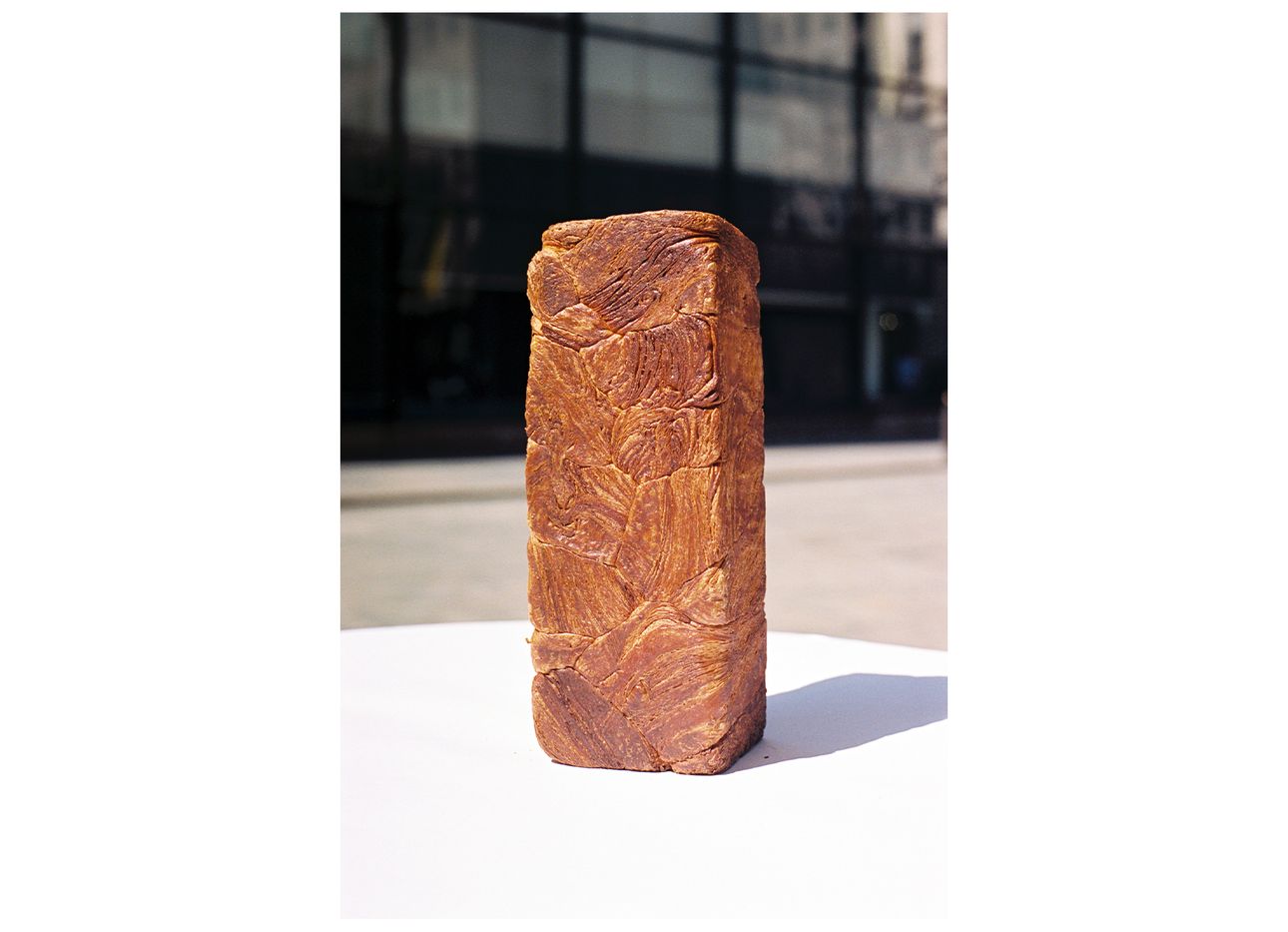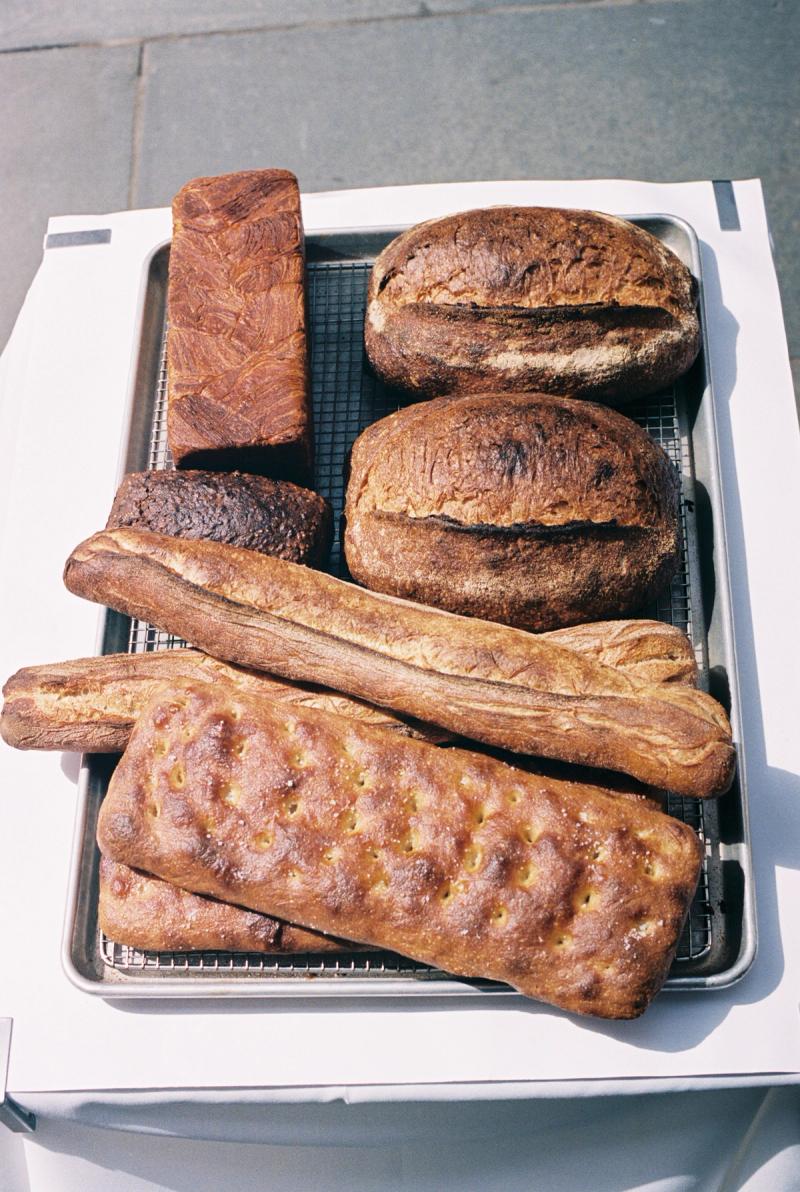
At New York’s Lodi, Braided Bread Tells the Story of Adaptive Reuse
Inspired by the unrushed pleasures of Milanese cafè culture, Uruguayan-born chef Ignacio Mattos opened the restaurant, bakery, and bar Lodi last September at New York City’s Rockefeller Center. There, head baker and pastry chef Louis Volle, who kneaded his way up from starting the bread program at Dean & Deluca to upstate New York’s Blue Hill at Stone Barns to San Francisco’s Tartine, leads a bread and pastry program that celebrates the age-old crafts of milling and baking. A large stone mill—among the first of its kind in Manhattan and visible through a window on Rockefeller Plaza—grinds single-variety grains, such as wheat and rye, into flour for Volle’s delectable baked goods, which rotate through Lodi’s ovens from morning to night.
A New Yorker who grew up in Paris, Volle turns out treats that are as scrumptious as they are photogenic. They range from pasticcini (small pastries) such as cornetto, flauto al cioccolato, and girella con pinoli; to bread such as pane di riso (rice bread) and mezza segale (rye). Perhaps the most compelling among these is his twelve-dollar Farro Piccolo, a French pain de mie–shaped loaf encased in an elegantly woven crust and made from upcycled dough.
To find out more about the ideas behind the bread, we recently spoke with Volle, who explained why the loaf symbolizes Lodi’s broader efforts to keep food waste at a minimum.
What’s the backstory to Farro Piccolo and its sustainable dough?
I’m glad you caught that, as not many people realize that this loaf of bread is a story of adaptive reuse. We’re currently milling nine different grain varieties at Lodi, and Tuesday is Einkorn milling day, which is what we use for the Farro Piccolo. It’s a special, beautiful grain that is difficult to grow, and unpredictable and challenging to work with—but worth the effort for its distinctive, nutty flavor. The Farro Piccolo is an enriched dough: a combination of laminated Einkorn dough and some of the laminated brioche, plus the trimmings of a couple of other laminated items.
At Lodi, we make croissants and pain au chocolat, which leaves some trimmings that we cut off to make their triangular shapes. Some bakers would just make additional croissants, but I like the laminations to be uniformly perfect. So I looked for another way to use the cutoffs that wasn’t an afterthought. I wanted something that was of the same high standard as our other baked goods, and that’s also delicious, unique, and purposeful. To make Farro Piccolo, we give the dough another single fold, cut it into strips, then braid them and bake them in a French pain de mie mold. By exposing the lamination, you get this beautiful pattern in the baking process.
Even if we didn’t have the trimmings from the laminations, I think we would still make Farro Piccolo. It’s become a symbolic product and something that we are very proud of.
Tell me more about the Einkorn dough. What is it made of, and where do the ingredients come from?
I pride myself on sourcing, so every ingredient is important. Even something as simple as the dairy we use—it comes from Finger Lakes Farms. Our cream from Pittsford Farms Dairy and our milk comes from Seneca Farms. It’s so good that one of our signature Lodi desserts is freshly spun gelato, which is just eggs, sugar, and milk. We use French Isigny butter for our laminations. Our salt is this Redmond sea salt harvested with a lot of clay sediment, which gives it the beautiful pink color.
Grains are equally important. The Einkorn dough for the Farro Piccolo is made of two grains: Einkorn, sourced from Camas Country Mills in Oregon, from farmers Tom and Sue Hunton, and one that we source from north of Seattle called Yecora Rojo, a hard red spring wheat known for its versatility. Einkorn is really a special grain, a relative of wheat but with a distinct taste and a beautiful color. But it’s quite difficult to grow, and doesn’t have much resiliency. It can also be difficult to work with. When you pull it, it doesn't snap back because it’s imbalanced flour. Consequently, for the Farro Piccolo, I pair it with laminated dough, since that process is one of stretching.
Besides its upcycled origins, what else makes Farro Piccolo special?
The aroma and depth of flavor is very distinctive, owing to its levain, an offshoot of a sourdough starter. We leave it to ferment for four days before we bake it, and the dough is mixed three days before it’s baked. So on the first day, the levain will be fed, then it goes into a dough that will be mixed, and that gets slowly proofed overnight in a cold environment. It’s laminated the next day, when you fold in the butter and shape it. Since it’s such a large piece, the loaf gets refrigerated another night. You get a real depth of flavor from this slow process. This is how I like to work with naturally leavened breads. Taking that time works both for ease of practice and for quality.
Fermentation is really important at Lodi. For everything leavened, it’s either entirely or partially leavened with culture instead of using a lot of yeast, which creates very lactic, sweet flavors. When it bakes, you get this beautiful caramelization.

How does Farro Piccolo fit into the other offerings at Lodi?
It’s symbolic of what we do here, where very little goes to waste. To use everything and waste nothing is really important to me. The Farro Piccolo in particular seems like it’s had a whole lifespan even before it comes out of the oven.
In the kitchen, we’re always working closely together to incorporate everything as much as possible. For example, we bake our Rustica baguette three times a day so it’s warm for our customers. Unsold ones from the morning will be used for griddled sandwiches, and the next day, become crostini. Whatever hasn’t sold by that afternoon, we use toasted for dinner service, and then anything remaining we’ll use the next morning on the breakfast menu, to serve with our frittata and smoked salmon. It’s also great for French toast.
Why is it called Farro Piccolo?
The name means “little farro,” because the Einkorn grain has far simpler genetic material than most wheat. It contains only fourteen chromosomes, whereas modern wheats contain forty-two, so this grain is smaller in size. Sometimes I’ll name things after the grain variety we use, and for this loaf in particular, because the idea for it came from this beautiful Einkorn, I wanted the name to reflect that. It’s also the largest bread we sell, so there’s a bit of humor to it.
Does Farro Piccolo represent the future of bread?
The more one works closely with farmers, like I do, the less you can avoid thinking about sustainability. I’ve seen and learned too much. That said, the future of bread is bright. I’m always working on new techniques or playing with how we can improve what we’re making. For the future of Farro Piccolo, we’re scalding it, which means pre-cooking the flour so that it gelatinizes, and then we fold that in with the bread dough. I’ve never seen this done with laminated breads before. Gelatinizing flours means you can work at higher percentages of whole grain, smoothing out the dough and achieving a higher percentage of hydration, which can change the aromas and bring about different tastes and flavors.
Our intention at Lodi is to be entirely transparent and showcasing what we do with all of our processes—that’s why anyone can look in our windows to see the mill swirling. This creates a dialogue, which leads to greater appreciation for what we’re doing. We hope that an ongoing conversation with our diners will foster greater understanding that what they’re looking at is a lot more than just sliced bread.